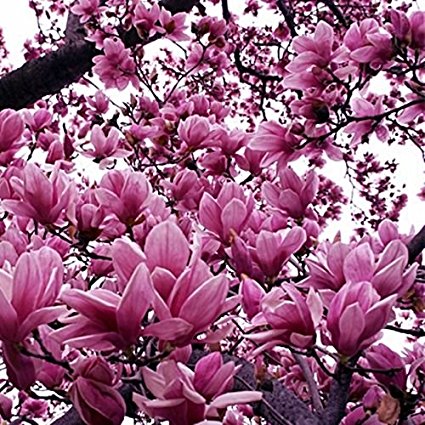New Account | Seed Mix |
Gift Certificates |AAS Winners |
Gardening Products
SEEDS: Unusual | Annuals | Perennials | Vegetables | Herbs | Trees
Magnolia Tree Seeds

FDR108 Lily Magnolia ( Magnolia liliiflora )
This magnolia is a shrub, not a tree. Lily magnolia is a bushy, rounded deciduous shrub which gets up to 13 feet high with a spread about the same. The leaves are large, to 8 inches long and 4 inches wide. The goblet shaped fragrant flowers are pink to purplish, about 3 inches across and produced in spring and sporadically through the summer.
Lily magnolia is best used as a specimen shrub. Its smallish size makes it suitable for the home landscape.
USDA Zones 6-9. Magnolia liliiflora has been known to survive winter temperatures as low as -4°F. Some of the cultivars and hybrids are hardy to zone 5. Lily magnolia does poorly in hot, dry climates. Late frosts sometimes damage early flowers.

Image: By Bruce Marlin [CC BY 3.0], via Wikimedia Commons
FDR109 Cucumber Tree ( Magnolia acuminata )
Magnolia acuminata, commonly called the cucumber tree, cucumber magnolia or blue magnolia, is one of the largest magnolias, and one of the cold-hardiest. It is a large forest tree of the Eastern United States and Southern Ontario, Canada. It is a tree that tends to occur singly as scattered specimens, rather than in groves.
Unlike most magnolias, the flowers are not showy. They are typically small, yellow-green, and borne high in the tree in April through June. The leaves of Magnolia acuminata are pointed at the tip and provide it with its name - 'acuminate' means tapering to a fine point. The name Cucumber Tree refers to the unripe fruit, which is green and often shaped like a small cucumber.
One of the few magnolias that will serve as a shade or lawn tree. Needs a large space. Flowers are fragrant and foliage releases a slightly spicy fragrance when crushed.
Hardy for zones 3-8.
Unlike most magnolias, the flowers are not showy. They are typically small, yellow-green, and borne high in the tree in April through June. The leaves of Magnolia acuminata are pointed at the tip and provide it with its name - 'acuminate' means tapering to a fine point. The name Cucumber Tree refers to the unripe fruit, which is green and often shaped like a small cucumber.
One of the few magnolias that will serve as a shade or lawn tree. Needs a large space. Flowers are fragrant and foliage releases a slightly spicy fragrance when crushed.
Hardy for zones 3-8.

